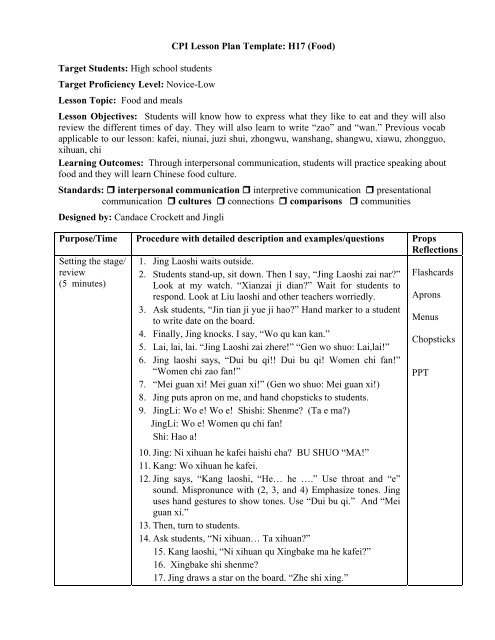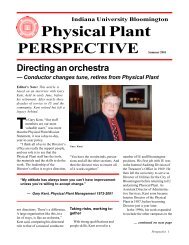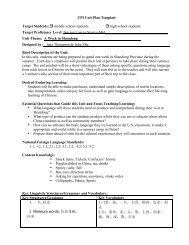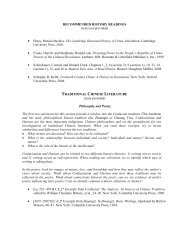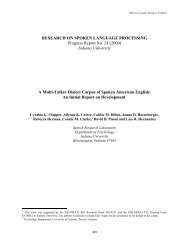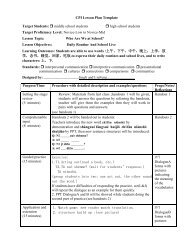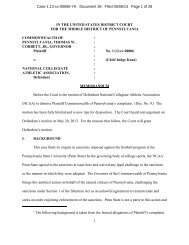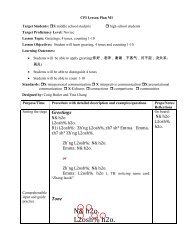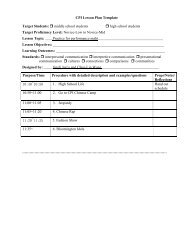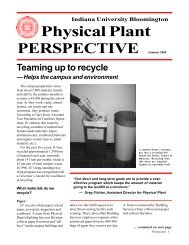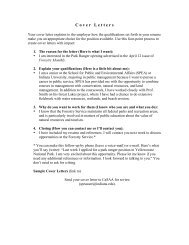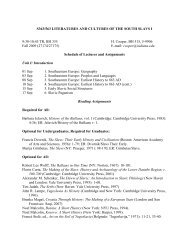CPI Lesson Plan Template: H17 (Food) Target Students: High ...
CPI Lesson Plan Template: H17 (Food) Target Students: High ...
CPI Lesson Plan Template: H17 (Food) Target Students: High ...
You also want an ePaper? Increase the reach of your titles
YUMPU automatically turns print PDFs into web optimized ePapers that Google loves.
<strong>CPI</strong> <strong>Lesson</strong> <strong>Plan</strong> <strong>Template</strong>: <strong>H17</strong> (<strong>Food</strong>)<br />
<strong>Target</strong> <strong>Students</strong>: <strong>High</strong> school students<br />
<strong>Target</strong> Proficiency Level: Novice-Low<br />
<strong>Lesson</strong> Topic: <strong>Food</strong> and meals<br />
<strong>Lesson</strong> Objectives: <strong>Students</strong> will know how to express what they like to eat and they will also<br />
review the different times of day. They will also learn to write “zao” and “wan.” Previous vocab<br />
applicable to our lesson: kafei, niunai, juzi shui, zhongwu, wanshang, shangwu, xiawu, zhongguo,<br />
xihuan, chi<br />
Learning Outcomes: Through interpersonal communication, students will practice speaking about<br />
food and they will learn Chinese food culture.<br />
Standards: interpersonal communication interpretive communication presentational<br />
communication cultures connections comparisons communities<br />
Designed by: Candace Crockett and Jingli<br />
Purpose/Time Procedure with detailed description and examples/questions Props<br />
Reflections<br />
Setting the stage/ 1. Jing Laoshi waits outside.<br />
review<br />
2. <strong>Students</strong> stand-up, sit down. Then I say, “Jing Laoshi zai nar?” Flashcards<br />
(5 minutes) Look at my watch. “Xianzai ji dian?” Wait for students to<br />
respond. Look at Liu laoshi and other teachers worriedly. Aprons<br />
3. Ask students, “Jin tian ji yue ji hao?” Hand marker to a student<br />
to write date on the board.<br />
Menus<br />
4. Finally, Jing knocks. I say, “Wo qu kan kan.”<br />
Chopsticks<br />
5. Lai, lai, lai. “Jing Laoshi zai zhere!” “Gen wo shuo: Lai,lai!”<br />
6. Jing laoshi says, “Dui bu qi!! Dui bu qi! Women chi fan!”<br />
“Women chi zao fan!”<br />
PPT<br />
7. “Mei guan xi! Mei guan xi!” (Gen wo shuo: Mei guan xi!)<br />
8. Jing puts apron on me, and hand chopsticks to students.<br />
9. JingLi: Wo e! Wo e! Shishi: Shenme? (Ta e ma?)<br />
JingLi: Wo e! Women qu chi fan!<br />
Shi: Hao a!<br />
10. Jing: Ni xihuan he kafei haishi cha? BU SHUO “MA!”<br />
11. Kang: Wo xihuan he kafei.<br />
12. Jing says, “Kang laoshi, “He… he ….” Use throat and “e”<br />
sound. Mispronunce with (2, 3, and 4) Emphasize tones. Jing<br />
uses hand gestures to show tones. Use “Dui bu qi.” And “Mei<br />
guan xi.”<br />
13. Then, turn to students.<br />
14. Ask students, “Ni xihuan… Ta xihuan?”<br />
15. Kang laoshi, “Ni xihuan qu Xingbake ma he kafei?”<br />
16. Xingbake shi shenme?<br />
17. Jing draws a star on the board. “Zhe shi xing.”
18. Kang: “ah! Wo hen xihuan qu Xingbake!”<br />
Show PPT. Pull down the screen.<br />
19. . Model with picture of “XingBaKe.”<br />
JingLi: Zhe shi ni ma?<br />
Shi: Shi a!<br />
JingLi: Ni zai nar?<br />
Shi: Wo zai Zhongguo!<br />
JingLi: Zhe shi nar?<br />
Shi: Zhe shi Xingbake!<br />
JingLi: Zhongguo you Xingbake ma?<br />
Shi: You!<br />
JingLi: Ni xihuan he Xingbake de kafei ma?<br />
Shi: xihuan<br />
Guess the meaning:<br />
Introduce “borrowed” words. Guess the meaning of the pinyin…<br />
McDonald’s and KFC<br />
Jingli: Kendeji shi shenme? Xingbake shi Starbucks.<br />
Jingli: Ni zuotian qu Maidanglao shi hanbaobao ma?<br />
Kang: Shi a! Hanbaobao hen hao chi!<br />
(KFC, McDonald’s) Show slide of McDonald’s. Even hanbaobao<br />
comes from the English word “hamburger.”<br />
Jingli: Shishi, Ni xihuan chi hanbaobao ma?<br />
Shi: Wo xihuan.<br />
JingLi: Hao! Women qu chi fan!<br />
Comprehensible<br />
input<br />
(8 minutes)<br />
Put up picture of people at the restaurant. Hand-out menus to each<br />
student. <strong>Students</strong> follow along with the menu as we explain the<br />
meaning of the new vocabulary through our PowerPoint images<br />
and dialogue.<br />
Culture: Explain the foods in China through photographs. As<br />
Chinese food culture is explained, we will also practice, “Ni jidian<br />
chi zaofan?”<br />
As I speak English, Jing will ask, “Ni jidian chi zhongfan?” and “Ni<br />
jidian chi wanfan?”<br />
Jingli: Shi,shi: Zhe shi shenme?<br />
ShiShi: Zhe shi ji.<br />
Jingli: Ni xihuan chi ji rou ma?<br />
早 饭<br />
中 饭<br />
晚 饭<br />
面<br />
牛 肉<br />
鸡 肉<br />
汤
Guided practice<br />
(15 minutes)<br />
Shishi: Xihuan.<br />
Shishi: Ni xihuan chi jirou ma?<br />
Jingli: BU xihuan.<br />
Act out “bu” and explain the meaning.<br />
***Go around and ask students to respond.<br />
(Then, I ask Jingli if she likes beef. Repeat with students.)<br />
Jingli: Ni xihuan chi niurou ma?<br />
ShiShi: Bu xihuan. Wo xihuan chi jirou. Ni xihuan chi niurou<br />
haishi jirou? (Review haishi)<br />
1. After we help students translate the menu from Chinese to<br />
English, we will practice the phrase, “Ni xihuan chi shenme?”<br />
饿<br />
渴<br />
Application and<br />
extension<br />
(15 minutes)<br />
Assessment and<br />
wrap-up<br />
(5 minutes)<br />
Homework/<br />
preview<br />
(2 minutes)<br />
1. We tell students we are preparing a school picnic and we need<br />
to prepare to order food. Two students will be go around and<br />
ask teachers and students what they like to eat. As students are<br />
filling-out the paper, we will continue to ask students what they<br />
like to eat.<br />
2. Jingli will teach how to write the characters “zao” and “wan.”<br />
1. We will ask students what other students and teachers like to<br />
write. “Emile, wanfan ta xihuan chi shenme?” “Ta zaofan<br />
xihuan he niunai.” <strong>Students</strong> will write “zao” and “wan” on the<br />
board—the rest will be in pinyin.<br />
2. <strong>Students</strong> will come to the chalkboard and write the pinyin and<br />
tone marks.<br />
1. Explain the homework. Review words in the word box.<br />
Handouts<br />
PPT
Chinese Pedagogy Institute 2008<br />
Jing Laoshi and Kang Laoshi<br />
<strong>H17</strong><br />
Homework<br />
Classroom Activity:<br />
Two students will help us plan the school picnic. Please go around and find out what each person<br />
likes to eat so that we can order the right amount of beef, chicken, or noodles. Thanks for your help!<br />
Name<br />
Emile Brandon<br />
Ta xihuan chi/he shenme?<br />
Ta xihuan x haishi y ?<br />
Shannon Brandon<br />
Corwin Deckard<br />
Asiyah Din<br />
Christopher Fowler<br />
Ane Jenkins<br />
Una Natterman<br />
Victoria Thacker<br />
Erika Weaver<br />
Eloise Weir<br />
___________ Laoshi<br />
___________ Laoshi<br />
___________ Laoshi
Chinese Pedagogy Institute 2008<br />
Jing Laoshi and Kang Laoshi<br />
<strong>H17</strong><br />
Homework<br />
饭 (Meal)<br />
Menu<br />
Translation<br />
面 条 miàntiáo ___________________<br />
牛 肉 niúròu ___________________<br />
牛 肉 面 niúròumiàn<br />
___________________<br />
牛 肉 汤 niúròu tāng<br />
___________________<br />
鸡 肉 jīròu ___________________<br />
鸡 肉 汤 jīròu tāng<br />
____________________<br />
饮 料 (Drinks)<br />
橘 子 水 júzishuǐ<br />
_____________________<br />
可 乐 kélè _____________________<br />
咖 啡 kāfēi _____________________<br />
牛 奶 niúnǎi _____________________<br />
茶 chá _____________________<br />
New Vocab:<br />
渴 kě thirsty Ex. Nǐ kě ma?<br />
饿 è hungery Ex. Nǐ è ma?
Chinese Pedagogy Institute 2008<br />
Jing Laoshi and Kang Laoshi<br />
<strong>H17</strong><br />
Homework<br />
Instructions: Practice making sentences with the new sentence structure “Wo xihuan chi<br />
_________.”<br />
Ex. Wo xihuan chi niu rou mian.<br />
Zaofan 早 饭 zhongfan 中 饭 wanfan 晚 饭<br />
Mian 面 niurou 牛 肉 jirou 鸡 肉<br />
Tang 汤 e 饿 ke 渴<br />
1. Wo xihuan/bu xihuan _______________________.<br />
2. Ni ______ ma?<br />
3. Ni xihuan chi _____________ haishi ______________?<br />
4. Ni _____________ chi shenme?<br />
5. Wo ______ dian chi zaofan.


